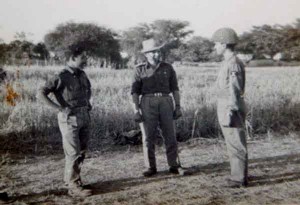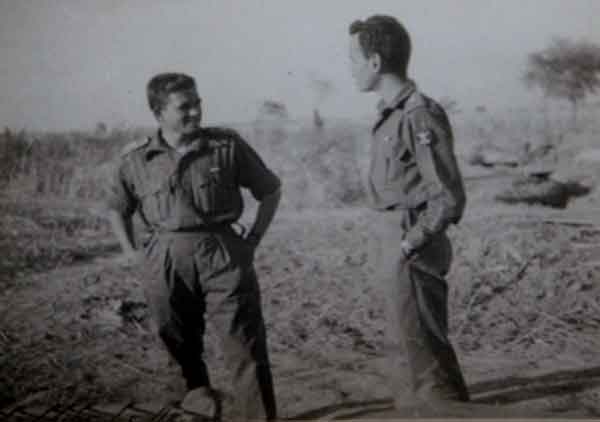For the whole of 8th and 9th September we did patrolling in the nearby villages surrounding Maharjke, for identification of Pakistani soldiers and locating their position. In some of the villages we identified considerable Pakistani militia concentrations, who were detailed to engage the inward moving Indian troops. In order to neutralize such villages, we used the tactics to block the exit route of the village and called for mortar fire, so that the shelling of area would cause the enemy concentration to break up and flee away before they could think of something else.
Likewise approximately 300 Pakistani villages were destroyed by the entire 6th mountain division put forward on the front of Sialkot sector. The entire ‘Sakargarh’ district was overrun by the 69th Infantry Brigade, in which Maharjke was situated and 20 to 30 villages were secured in addition.
The artillery shelling done in response of Pakistani howitzer fire proved quite effective.
On 10th September we had achieved a firm control over our first objective, so the senior officials of the brigade were occupied in further planning of the much needed things with their ‘Army Supply Core’ counterparts as we had made a vital break through enemy lines and were not in a mood to retreat under any circumstances. While the people from medical core were engaged in treating the wounded soldiers we found that most of the casualties that we received were mainly due to the shelling which had taken place, when we were inching our way towards Maharjke through unprotected farms and because of the machine gun fire. I found out that my batman, who was crawling just next to me, was killed by one of the bullet shots fired from those guns. But he was not the only one who faced abrupt death, there were many more like him who died before we were able to silence those guns.
The artillery shelling done in response of Pakistani howitzer fire proved quite effective. Since the fear of a brigade size attack was more than enough to make the entire town vacant, well before we reached at its gates. In the late evening when I was on patrolling duty we heard an echoing sound of armored columns approaching Maharjke. I thought that these must be the Pakistani tanks since they were coming from deep inside Pakistan. Nor had we been informed about any such tank movement by our commanders neither we knew about any Indian armored formation closer to us. Keeping an eye on the movement of those armored vehicles I contacted Captain Oberoi who in turn contacted Lieutenant Colonel Bhattacharya and reported the matter to him. When he learnt about the fact he too was astonished and quickly contacted his superiors. It was only then we came to know that these tanks belonged to the Indian Armored Corps and were returning from ‘Phillora’.
Such was then the tensed atmosphere in war, which at times becomes more or less chaotic. While a person is in the battle ground he has to depend more on his senses than anything else because at last it is the soldier himself who has to take vital decisions keeping in mind a lot many things including the responsibility of life of men, under his command.
As expected our next target was now to capture Phillora. The brigade commander in accordance with the three battalion commanders had laid down the immediate plan of action and the same night we started our travel towards Phillora.
When the tank columns reached closer, I along with my patrol party went ahead and interrupted them. Learning the fact that we were Indian soldiers, from one of the tanks a Sikh commander came out and let us know what had happened in Phillora. He told that Pakistanis used ‘Blitzkrieg’ tactics to counter our armored regiments.
Blitzkrieg was an effective tactics used in world war-2 by the Germans for routing the opponent forces in which a combination of air attack, armored support and artillery cover is provided, resulting in a strong blow. This tactics can be countered only when the strength of infantry is quite large. The Indian top brass however depended on the much older ideology of wave attacks, in which wave after wave of either infantry or armored regiments would be thrown on the enemy. The big disadvantage of this way of fighting is that there is a possibility of lack of proper co-ordination and heavy casualty.
After we escorted those armored columns to the brigade headquarter we came to know about one more news which was a bad one. In the link-up with our brigade they informed that in the early hours of war the armored regiments were pushed in to halt the Pakistani advance, well before the mountain divisions had arrived on the Punjab front. At Phillora the Pakistanis, owing to air support destroyed an entire column of fourteen tanks, including that of column’s commander.
As expected our next target was now to capture Phillora. The brigade commander in accordance with the three battalion commanders had laid down the immediate plan of action and the same night we started our travel towards Phillora.
Battle of Phillora
As we started for Phillora, we were accompanied by a tank regiment, consisting mostly of Sherman and Stuart tanks, to provide armored support. All of us got mounted on the tanks and began to mentally prepare for another but much awaited encounter with the enemy. Phillora was approximately 10 kilometers away from Maharjke. Since our battalion had already seen action before, so most of the people were keeping a calm state of mind which was much needed at that moment.
Many of the soldiers though appeared to be relaxed but somewhere in the back of their mind had an unfulfilled desire of giving the Pakistanis their piece of mind.
On 11th September, in the early day hours we reached outskirts of Phillora. But perhaps the Pakistani Air Observation Post (AOP) had identified our movement and we were attacked with several rounds of artillery fire. The moment the fire started we jumped from the tanks and quickly took defensive positions nearby. The tanks had to be camouflaged in the fields to prevent them from getting pin-pointed by the Pakistani Air Observation Post.
After few hours, when the shelling stopped I along with 2nd Lieutenant Dalal were send by our respective company commanders for forward patrolling in the enemy area for identification of their location, manual and material strength. Slowly we creped inside the town with our columns from different sides only to find out that it had been already vacated. Probably the initial attack made by the Indian armored regiments was fierce enough to make Pakistanis run away.
We came across many name plates outside the houses which indicated that Phillora was the home of many Pakistani army personals. After the town was cleared by us we established a few more defensive positions just outside the town, facing Pakistan so that any counter attack made by the Pakistani militia could be handled appropriately.
Many of the soldiers though appeared to be relaxed but somewhere in the back of their mind had an unfulfilled desire of giving the Pakistanis their piece of mind. For consoling such enthusiastic lads of mother India, we carried out aggressive patrolling in the villages surrounding Phillora, since from our experience at Maharjke we had become aware of the Pakistani tactics of guerilla warfare. The Pakistani militia was abandoning big towns like Phillora and took refuge in the close by villages for re-grouping themselves.
We adopted the usual method of clearing such areas. A group of soldiers would attract the enemy fire from one side, all the exit routes were blocked and two teams consisting of 3 to 4 soldiers would lit up the village from behind the enemy or mortar fire was called upon.

2nd Lieutenant Jacob, 2nd Lieutenant Baljit Singh along with a fellow officer in a sugar cane field near Phillora
On one such occasion I led a column of soldiers to neutralize a village, which was reported to be containing Pakistani militia. The location of that village was such that it was not much easy to get a clear idea of the enemy hide out. In order to get a better view of the things I climbed up a tree which was over-looking the village. The moment I reached a sufficient height, from which the whole village could be seen, a salvo of bullets were fired at the tree. Although I had taken a risk but it did not go in vain. I was able to locate the enemy hide out and by the fire power, which they had advertised, an idea of their strength was obtained. Guiding the soldiers to block the exit routes I called for retaliatory mortar fire and within no time the enemy concentration had been neutralized.
But as it happens on most occasions that for achieving a goal you have to give something. Like Maharjke in Phillora too we had casualties in the form of loss of life. After reaching Phillora we had secured the area around the town. But this fact in addition of being known to our superior officials was also known to Pakistanis, who taking advantage of the concentration of troops use to rain artillery fire on the town, aiming at us. In one such fire which took place in the morning hours killed Major Chaudhary, the commander of Bravo Company. He had just come out of his position for having a view of the things when Pakistani artillery fire started and one of the shells exploded just next to him, cutting him down. Later to fill the void created due to his death, Major Nerula joined as commanding officer of Bravo Company in the midst of the war.
This was just an example of the ‘anything possible’ situation, which prevails throughout the war.






Nice realistic and true story